South East Coalville Growth Scheme (2016)
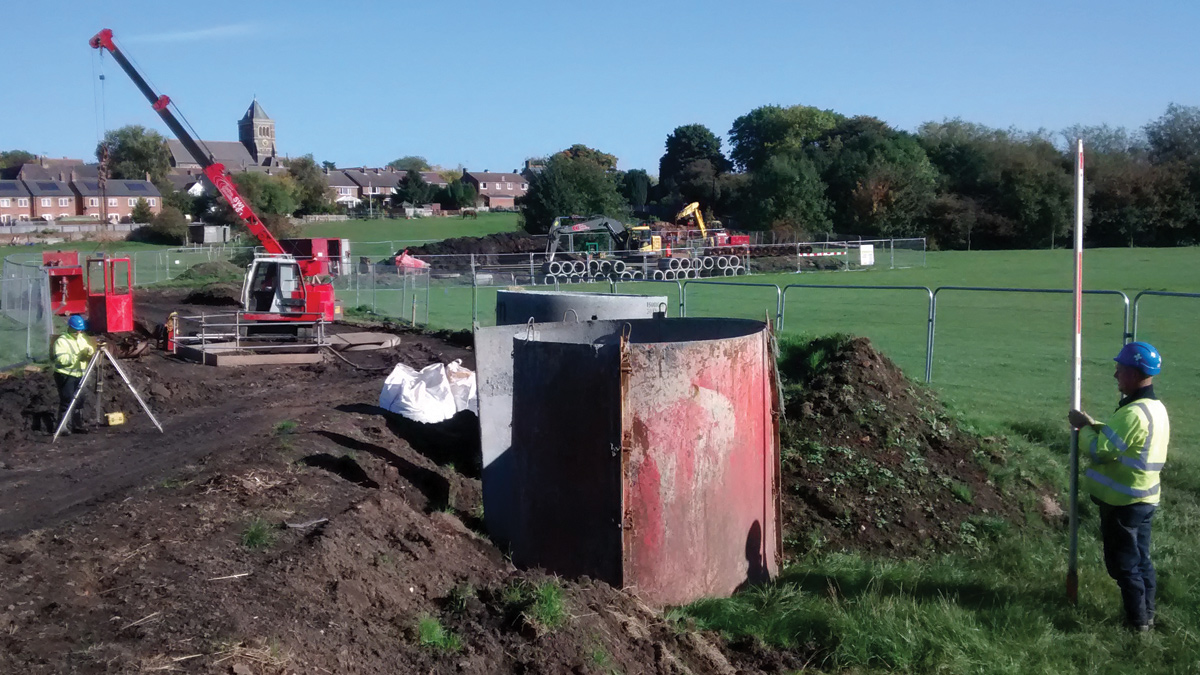
Construction of drive/reception pits in Hugglescote Recreation Ground (former landfill tip) - Courtesy of NMCNomenca (now Galliford Try)
North West Leicestershire District Council’s long term housing proposals include an allocation of 3,200 dwellings to the south east of Coalville. Without sewer capacity improvements the additional flows will increase flood risk and combined sewer overflow (CSO) spills and so proactive capacity improvements are required to meet Severn Trent Water’s AMP6 outcomes to ‘safely take wastewater away’ and ‘ to protect the local environment’. The South East Coalville Growth Scheme was phase 1 of a wider long term growth strategy to increase sewer capacity, providing for future planned development in Coalville. By examining the requirements as a catchment strategy rather than a short term fix, the Severn Trent Water Investment Planning team ensured the lowest long term expenditure.
Project background
The project, developed by Severn Trent’s Solution Team and constructed by NMCNomenca (now Galliford Try), forms Phase 1 of the wider South East Coalville Long Term Growth Strategy. Acceleration of Phase 1 was required to align with the developer’s build profile and has provided the first section of a gravity sewer required to enable the long term strategy. This work has allowed connection of 105 dwellings at the end of 2015 and a further 550 dwellings by the end of AMP6.
The works included the provision of 700m of 600mm diameter link sewer from Grange Road, Hugglescote to the south west, running through private land, woodland and Hugglescote recreation ground (a former landfill site). A 225mm diameter temporary connection has been made from the south side of the recreation ground to the existing 300mm diameter sewer in Station Road. These works have also allowed the abandonment of the existing Grange Road Sewage Pumping Station (SPS).
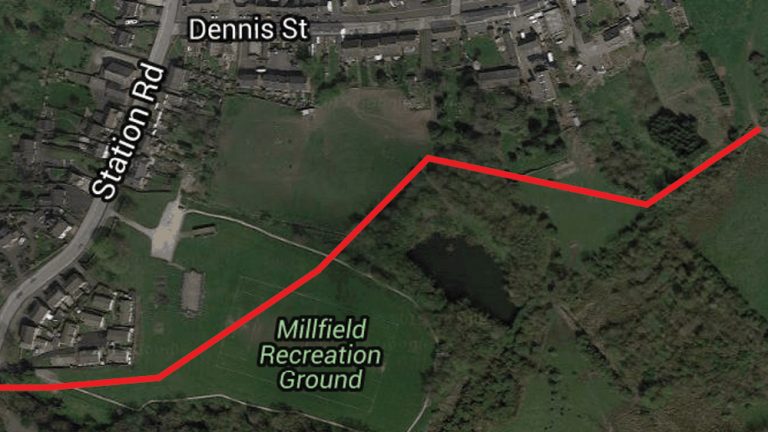
Route of the new 600mm diameter sewer – Courtesy of NMCNomenca
Severn Trent’s long term strategy takes a ‘catchment approach’ to maximise the opportunities presented by the need to provide new sewerage infrastructure for the planned development. This long term view has identified opportunities to transfer flows from ‘stressed’ areas of the existing network, abandon several pumping stations and rationalise CSOs, which together will provide greater sustainability for the future.
Innovation
The main sewer route runs through an area of woodland and a former landfill site under Hugglescote recreation ground. No-dig construction techniques were implemented using guided auger bore to install 330m of the 600mm diameter sewer through these areas to reduce health and safety risk, programme and removal of potential contaminated excavated material. The sewer invert levels were designed so that it was installed below the base of the landfill, depth 5-6m below existing ground level.
During the design phase it was essential to establish the invert level of the existing 300mm diameter sewer in Station Road in order to make a temporary connection for the phase 1 works. It was not possible to dig a trial hole directly over this sewer due to the presence of utility services (gas, water and electricity) which had been laid above. In order to avoid expensive service diversions, the sewer was accessed by constructing a timber heading under the services and level obtained. To avoid repeating the process during the main contract, a connection was made to the sewer and offset manhole constructed during the site investigation phase (see below).
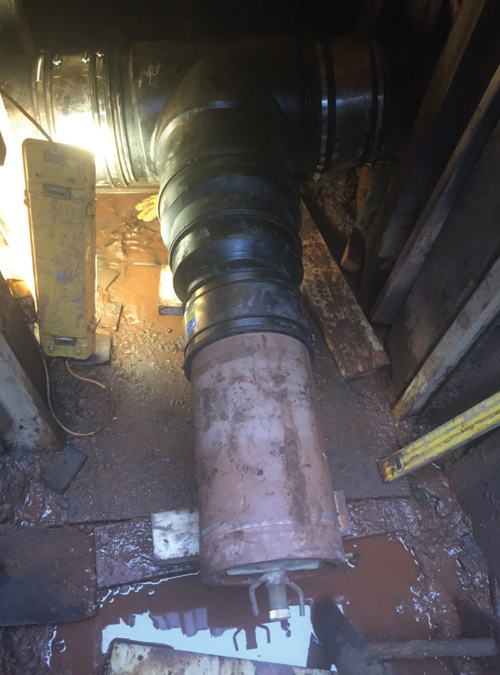
Temporary connection to existing sewer in timber heading- Courtesy of NMCNomenca
Sustainability
The new sewer will relieve existing overloaded sewers therefore reducing the risk of sewer flooding/pollution. It allows for further future development in the area to connect to a gravity sewer avoiding the need for Severn Trent to adopt two new developer pumping stations that would otherwise be required to pump flows from the future development. It also enables the decommissioning of the existing SPS in Grange Road by removing the flow from the 115 dwellings that are currently connected, providing an OPEX saving.
Project management and procurement
A partnership agreement was entered into with the tunnelling contractor, Active Tunnelling Ltd, to enable the most cost effective delivery of the project. The partnership agreement between the contractor and the no-dig contractor was a first for NMCNomenca, with a bespoke contract arrangement to incentivise collaborative working.
The sub-contractor was involved from the early phases of the scheme during the design phase. This stimulated and focussed the key principles of the design to satisfy the client solution requirement and yet promote efficiencies pre-site and also during the construction phase.
Of particular focus were:
- The determination of effective lengths for the no-dig works based on extensive interpretive ground condition checks.
- Minimal but effective drive & reception pit locations.
- Dealing with an old landfill tip.
- Dealing with/crossing nearby watercourses.
- A nearby fishing pond with respect to the reaming process (groundwater control).
- Livestock fields.
- Public rights of way.
- The housing developer coordination requirements in terms of connection and their particular timescale constraints.
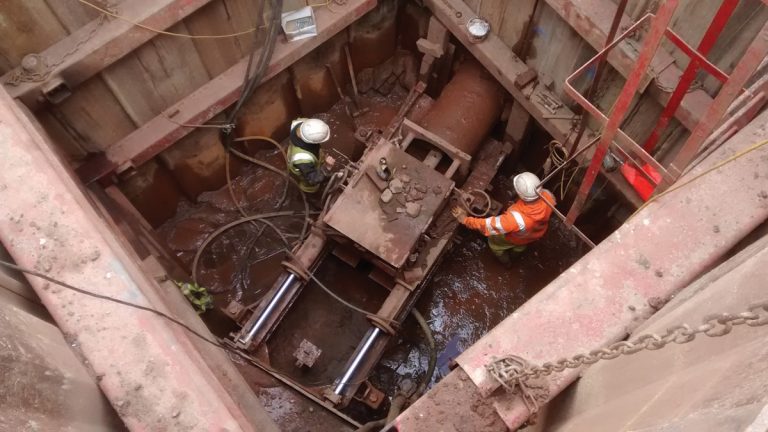
Auger bore drive pit – Courtesy of NMCNomenca
During the construction phase the focus on partnership and efficiency continued whilst the rationalised design was installed. The primary consideration for the team throughout construction was; “who can provide the required elements the cheapest and quickest to get our solution installed safely?”
Whilst the construction phase was not without its own challenges, the collaborative team effort drove the project installation from start to finish and consequently delivered the scheme ahead of our original programme and under the project target price.
An agreement was made with the housing developer to ‘self- lay’ 200m of the new 600mm link sewer as part of their on-site adoptable drainage works. Agreement was also obtained to use the development site as a location for the compound which gleaned additional efficiencies for both NMCNomenca and the developer following on from the works.
Application of engineering principles and judgement
Providing long term capacity in a sewerage system requires significant judgement based on the best information available today. By working very closely with the planning authority and developers, Severn Trent’s Solution Team was able to determine the best use of existing assets, identify the optimum sewer routes to service the overall development and mitigate short term operational risks. This included understanding the headroom available in the existing 7km-long Kelham Bridge SPS rising main to deliver future flows to treatment, embedding Severn Trent’s long term infrastructure strategy within the planning authority’s growth plans and having a detailed understanding of system performance throughout the entire design horizon to determine the best TOTEX investment profile.
The new sewer line and level was designed so that future developments upstream could be connected by gravity and a permanent future downstream connection to Kelham Bridge SPS could be achieved. Maximising the depth to allow this, brought the added benefit of locating the sewer beneath the base of the former tip removing the need to treat and dispose of contaminated material, an impact that far outweighed the additional cost for the deeper drive and reception pits.
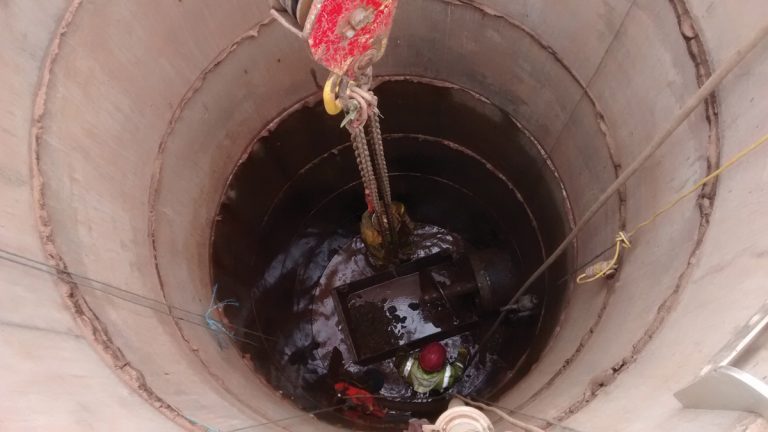
Auger bore reception pit – Courtesy of NMCNomenca
Whole project impact
Most of the phase 1 work took place on private land and was managed by negotiation with the individual landowners. The works in the recreation ground had the potential to seriously impact on a children’s play area, football pitch and a public right of way. The choice of no-dig techniques minimised this impact as it was possible to keep the play area open and divert the rights of way.
The area between Bardon Road, Grange Road and Beveridge Lane has been identified by North West Leicestershire District Council as a development area for up to 3,500 new dwellings. Approximately 1,800 of these dwellings will eventually gravitate through the new link sewer (up to 655 by the end of AMP6). The developments are currently at different stages of the planning process; some have full planning applications which are awaiting approval and others have outline approval granted. The overall timescale for the development is up to 2032.
There was no existing sewerage within this area of the catchment and without the link sewer any new developments would be required to connect to the existing system by multiple pumped connections. In viewing the development around the Coalville catchment as a strategy instead of a single growth scheme Severn Trent have realised a true whole life TOTEX saving by investing now to construct the new link sewer, avoiding the future operational and maintenance cost of multiple pumping stations.
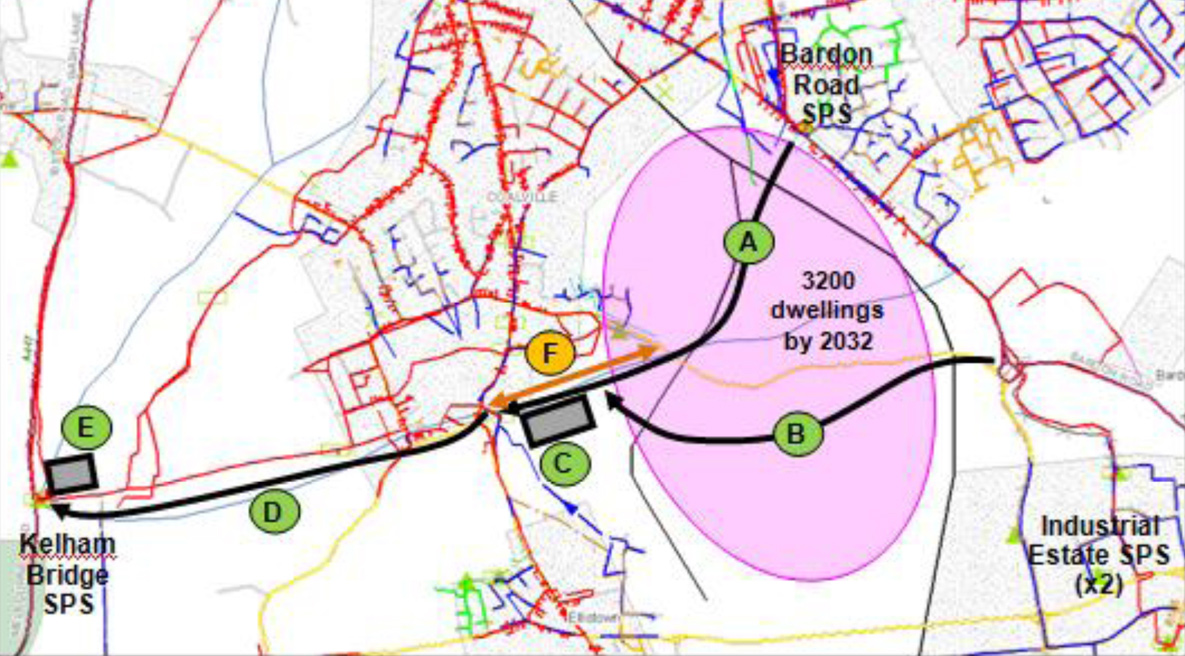
Schematic showing how the link sewer (marked ‘F’) fits into the long term strategy – Courtesy of NMCNomenca
Conclusion
The link sewer is a key element in providing capacity for sewerage growth in the Coalville area to the end of AMP6 and beyond.
Construction of this £1.2m project started in January 2015 and completed in December. The contractor was NMCNomenca and the key supply chain partner was Active Tunnelling Ltd
The overall strategy will confirm the additional sewerage required as development progresses in to AMP7 and AMP8. However, irrespective of the sewerage provisions necessary downstream, the proposed link sewer shall be essential. The plan above shows how the link sewer (marked ‘F’) fits into the long term strategy.




